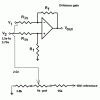Hi board ,
I am using the following circuit. Now when the voltage at V2 starts to vary from 2.5V to 3.75V . I measure a shift at V1 as well from ( 2.5v to 2.65v) which is disrupting the output signal and is strange . Have I done something wrong ? I am using OPA2335 .
Thanks in Advance
-Dark
I am using the following circuit. Now when the voltage at V2 starts to vary from 2.5V to 3.75V . I measure a shift at V1 as well from ( 2.5v to 2.65v) which is disrupting the output signal and is strange . Have I done something wrong ? I am using OPA2335 .
Thanks in Advance
-Dark
Attachments
Last edited:



